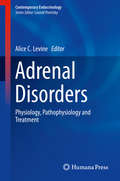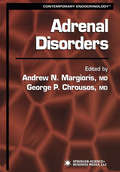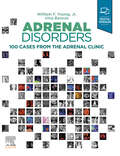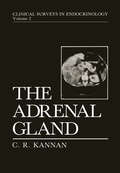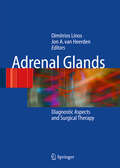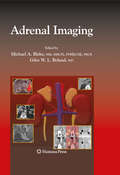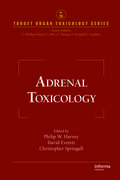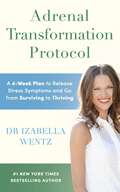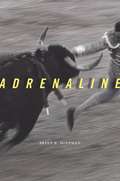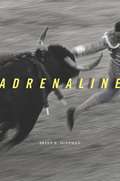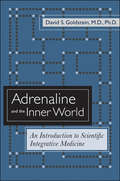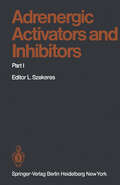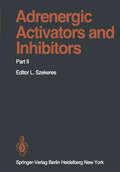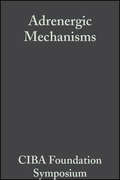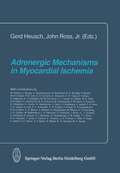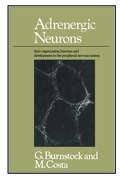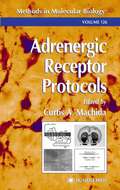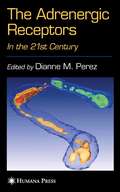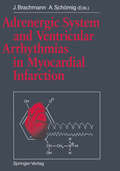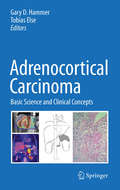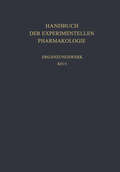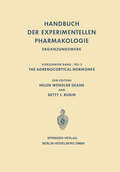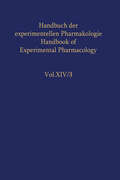- Table View
- List View
Adrenal Disorders: Physiology, Pathophysiology and Treatment (Contemporary Endocrinology)
by Alice C. LevineThis practical resource provides the latest evidence, management strategies and recommendations for the treatment of disorders of the adrenal glands, including related physiology, genetics and pharmacology. This book is divided into three thematic sections. The first covers adrenal physiology, presenting adrenal zonation and development, the regulation of steroidogenesis, and the pharmacology of glucocortisoids. Part two discusses the genetics and pathophysiology of a number of adrenal disorders, including autoimmune Addison’s disease, congenital adrenal hyperplasia, primary aldosteronism, adrenocortical tumors and hyperplasias, and pheochromocytomas and paragangliomas. The final section presents the latest diagnostic and management strategies for these disorders, addressing adrenal insufficiency, adrenal Cushing’s Syndrome and aldosteronism, among others.Over the past twenty years, our understanding of disorders of the adrenal glands has been altered and deepened. Providing a much-needed update to the literature, Adrenal Disorders: Physiology, Pathophysiology and Treatment will be an important resource for both academic and clinical endocrinologists working with the adrenal glands and managing patients with adrenal disorders.
Adrenal Disorders (Contemporary Endocrinology)
by Andrew N. Margioris George P. ChrousosIn Adrenal Disorders, a panel of distinguished physicians and researchers select the most relevant new findings and integrate them into the existing body of clinical knowledge on adrenal pathologies. The book includes important reviews of disturbances in cortisol homeostasis, and new concepts regarding adrenal tumors and hereditary adrenal diseases. Also discussed are mineralocorticoids and the syndromes of mineralocortoid excess and aldosterone synthase deficiency. Authoritative and insightful, Adrenal Disorders provides physicians and scientists with a comprehensive, state-of-the-art practical guide to the devastating diseases of the adrenals that are so often difficult to diagnose and treat.
Adrenal Disorders,E-Book: Cases from the Adrenal Clinic
by William F. Young Jr. Irina BancosAdrenal disorders are often difficult to diagnose due to common symptoms, and challenging to treat due to common comorbidities. Adrenal Disorders: 100 Cases from the Adrenal Clinic provides a comprehensive, case-based approach to the evaluation and treatment of both common and uncommon adrenal disorders, offering practical, real-world guidance highlighted by ultrasound scans, biopsy images, and tables. Features 100 two-page cases covering a wide range of common and uncommon adrenal disorders. Includes case report, investigations, treatment, and outcome for each case, plus a case overview with expert advice, take-home points, and references. Organizes comprehensive content by type of disorder, including adrenal masses (benign and malignant), primary aldosteronism, ACTH-independent Cushing syndrome, ACTH-dependent Cushing syndrome, adrenal carcinoma, and pheochromocytoma.
The Adrenal Gland (Clinical Surveys in Endocrinology #2)
by C.R. KannanThis volume, The Adrenal Gland, is the second in the Clinical Surveys in Endo crinology series. Like its predecessor on the pituitary gland, this work is written with one purpose in mind-to view the vast, relevant adrenal literature through a clinician's eyes. The intricate, and often complex, interrelationship between the clinical and research perspectives of "adrenology" poses a challenge. This is, in part, due to the commonly held belief that the milieux of steroid hormone research and clinical medicine are parallel phenomena, not destined to meet. But the twain do meet, and often with relative ease, when viewed as twin facets of the same gem. The view presented in this work is from the vantage point of the clinical endocrinologist who applies the research literature to understand adre nal diseases more clearly. Adrenal pathology is arguably the most fascinating of all endocrinopathies. The images of patients suffering from adrenal diseases are of kaleidoscopic quality: the newborn child with ambiguous genitalia, in whom the very first ritual of assigning sex becomes shrouded with uncertainty; the revitalized pa tient with hitherto undiagnosed Addison's disease, who but for the cognitive powers of the endocrinologist would have ultimately succumbed, undiagnosed; the virilized female with adrenal tumor and its attendant onslaught on the body and mind; the febrile patient with pheochromocytoma masquerading as fever of undetermined origin for months.
The adrenal gland (contracted)
by RnibThe labelled diagram shows the adrenal glands and kidneys. A locator dot and title are shown. These must always be at the top left of the page when the image is the right way up.
The adrenal gland (large print)
by RnibThe labelled diagram shows the adrenal glands and kidney.A locator dot and title are shown. These must always be at the top left of the page when the image is the right way up.
Adrenal Glands: Diagnostic Aspects and Surgical Therapy
by Dimitrios A. Linos Jon A. Van Heerden- Over 200 exquisite illustrations, ranging from intraoperative photographs, line drawings, diagnostic images, pathology slides, tables and graphs are available to make each case discussed comprehensible and easy to follow. - Traditional and novel therapeutic recommendations are introduced and the latest developments in minimal-access operative techniques are discussed and reviewed. - Focuses on a teamwork oriented approach that identifies the necessary communications amongst the many medical disciplines when dealing with adrenal disorders.
Adrenal Imaging (Contemporary Medical Imaging)
by Giles Boland Michael A. BlakeImaging of the adrenal gland has made tremendous progress in the last decade as new technologies continue to evolve. Adrenal Imaging highlights the pertinent clinical and pathological information that underpins the accurate interpretation and use of adrenal imaging. Written by a prestigious group of international contributors, individual chapters in Adrenal Imaging serve as a relevant and up-to-date reference of adrenal imaging findings, algorithms and techniques in CT, MR nuclear medicine, intervention and trauma. Summary sections at the end of each chapter illuminate key teaching points to enhance retention.
Adrenal Toxicology
by Philip W. Harvey David J. Everett Christopher J. SpringallDespite being regarded as the most common toxicological target in the endocrine system, the adrenal gland has often been neglected in regulatory testing. Adrenal Toxicology addresses the increased interest in adrenocortical toxicology and the need for a resource that makes techniques available to examine adrenal endocrine disruption. Examining curr
Adrenal Transformation Protocol: A 4-Week Plan to Release Stress Symptoms and Go from Surviving to Thriving
by Dr Izabella WentzOvercome fatigue, brain fog and anxiety, and gain energy, clarity and peace of mind with Dr Izabella Wentz, internationally acclaimed thyroid specialist and #1 New York Times bestselling author.What were you doing in your life before you got sick? This is a common question Dr Izabella Wentz asks her clients when trying to get to the root cause of symptoms such as low energy, sleeplessness, caffeine dependency and poor memory. More often than not, she found they developed their symptoms after a period of acute or chronic stress: starting a new business, having a baby or living through a global pandemic - these can all destroy our once-resilient stress response.Since Dr Wentz was diagnosed with Hashimoto's thyroiditis at the age of twenty-seven, she has sought to help her clients eliminate symptoms of stress, fatigue and burnout, and manage problems that conventional medicine has failed to address. In Adrenal Transformation Protocol, Dr Wentz tackles adrenal dysfunction, the body's inability to produce essential hormones when it mismanages stress, and shows that by making a few small dietary and lifestyle changes, you can see profound improvement within weeks.In this simple four-week programme, Dr Wentz will help you identify your adrenal triggers, balance your stress response and build up resilience to prevent stress from overwhelming your adrenals in future.
Adrenaline
by Brian B. HoffmanFamous as the catalyst of the fight or flight response, adrenaline has also received forensic attention as a perfect, untraceable poison—and rumors persist of its power to revive the dead. True to the spirit of its topic, Adrenaline is a stimulating journey that reveals the truth behind adrenaline’s scientific importance and popular appeal.
Adrenaline
by Brian B. HoffmanFamous as the catalyst of the fight or flight response, adrenaline has also received forensic attention as a perfect, untraceable poison—and rumors persist of its power to revive the dead. True to the spirit of its topic, Adrenaline is a stimulating journey that reveals the truth behind adrenaline’s scientific importance and popular appeal.
Adrenaline and the Inner World: An Introduction to Scientific Integrative Medicine
by David S. GoldsteinThis accessible work is the first in more than seventy-five years to discuss the many roles of adrenaline in regulating the "inner world" of the body. David S. Goldstein, an international authority and award-winning teacher, introduces new concepts concerning the nature of stress and distress across the body's regulatory systems. Discussing how the body's stress systems are coordinated, and how stress, by means of adrenaline, may affect the development, manifestations, and outcomes of chronic diseases, Goldstein challenges researchers and clinicians to use scientific integrative medicine to develop new ways to treat, prevent, and palliate disease. Goldstein explains why a former attorney general with Parkinson disease has a tendency to faint, why young astronauts in excellent physical shape cannot stand up when reexposed to Earth's gravity, why professional football players can collapse and die of heat shock during summer training camp, and why baseball players spit so much. Adrenaline and the Inner World is designed to supplement academic coursework in psychology, psychiatry, endocrinology, cardiology, complementary and alternative medicine, physiology, and biochemistry. It includes an extensive glossary.
Adrenergic Activators and Inhibitors: Part I (Handbook of Experimental Pharmacology #54 / 1)
by Nils-Erik Anden J. M. Armstrong A. Arnold J. Bläsig S. Ellis J. S. Gillespie A. F. Green G. Hertting A. Herz E. G. Krause J. F. Marshall M. W. McCullloch D. K. Meyer R. D. Myers J. Gy. Papp J. R. Parratt P. N. Patil A. Philippu D. K. Phillips M. J. Rand R. R. Ruffolo P. Säynävälammi H. Scholz D. F. Story L. Szekeres U. Ungerstedt H. Vapaatalo L. Will-Shahab J. F. WhitfieldNot much more than a decade has passed since the appearance of the outstanding handbook, Catecholamines, edited by BLASCHKO and MUSCHOLL, in the series: Handbook of Experimental Pharmacology. However, this extremely well organized volume dealt mainly with the origin, molecular actions, and fate of the naturally occuring catecholamines. It was felt that a separate volume should be dedicated to the remarkable and exciting progress made in the field of agents influencing the adrenergic system, both in physiologic and pharmacologic respect. The editor of the present volume considers himself lucky to have been able to persuade a number of eminent specialists to collaborate. The main concept of the present handbook is a systematic approach to the various effects of adrenergic activators and inhibitors starting with the chemistry and structure actitivity relationship, followed by the evaluation of adrenergic activators and inhibitors, and discussing their mode of action. The most voluminous part is the chapter dealing with the systemic pharma cology of these agents analyzing the effects on the central nervous system, on the autonomic nervous system, on the cardiovascular, the respiratory, the digestive, the endocrine system, on the skeletal muscle, and on metabolism. Kinetics and bio transformation, further toxic effects are discussed in the following chapters. A special chapter on clinical features concludes the monograph.
Adrenergic Activators and Inhibitors: Part II (Handbook of Experimental Pharmacology #54 / 2)
by D. M. Aviado W. C. Bowman Geoffrey Burnstock J. Greven J. Hannappel P. Juul A. Kahan L. Kovacs M. S. Micozzi H. Osswald C.W.I. Owens D. E. Potter B.N.C. Prichard K. H. Rahn D. Robertshaw M. Sas A. J. Smith H.A.J. Struyker-Boudier G. T. Tucker J. Tuckman H. WongAdrenergic Mechanisms (Novartis Foundation Symposia #946)
by G. E. W. Wolstenholme Maeve O'ConnorThe Novartis Foundation Series is a popular collection of the proceedings from Novartis Foundation Symposia, in which groups of leading scientists from a range of topics across biology, chemistry and medicine assembled to present papers and discuss results. The Novartis Foundation, originally known as the Ciba Foundation, is well known to scientists and clinicians around the world.
Adrenergic Neurons: Their Organization, Function and Development in the Peripheral Nervous System
by Geoffrey Burnstock CostaAdrenergic Receptor Protocols (Methods in Molecular Biology #126)
by Curtis A. MachidaAdrenergic receptors are important modulators in the sympathetic c- trol of various metabolic processes in the central and peripheral nervous s- tems. These receptors are localized at multiple sites throughout the central nervous system (CNS) and serve as important regulators of CNS-mediated behavior and neural functions, including mood, memory, neuroendocrine c- trol, and stimulation of autonomic function. Adrenergic Receptor Protocols consists of 35 chapters dealing with va- ous aspects of adrenergic receptor analyses, including the use of genetic, RNA, protein expression, transactivator, second messenger, immunocytochemical, electrophysiological, transgenic, and in situ hybridization approaches. This volume details the use of various methods to examine the adrenergic receptor system, using aspects of the genetic flow of information as a guide (DNA? RNA ? transactivator ? protein expression ? second messenger analyses ? cellular analyses ? transgenic whole animal approaches). Adrenergic Receptor Protocols displays step-by-step methods for s- cessful replication of experimental procedures, and would be useful for both experienced investigators and newcomers in the field, including those beg- ning graduate study or undergoing postdoctoral training. The Notes section contained in each chapter provides valuable troubleshooting guides to help develop working protocols for your laboratory. With Adrenergic Receptor Protocols, it has been my intent to develop a comprehensive collection of modern molecular methods for analyzing adrenergic receptors. I would like to thank the many chapter authors for their contributions.
The Adrenergic Receptors: In the 21st Century (The Receptors)
by Dianne M. PerezAn authoritative review of the current state-of-the-art understanding of the structure and function of the adrenergic receptor subtypes, as well as of the role played by these receptors in physiological and pathophysiological settings. Topics range from structure-function studies and the imaging of adrenergic receptors to the use of genetically altered mouse models and pharmacogenomics. Highlights include a survey of the knockout and overexpressed mouse models, a review of the new ways that adrenergic receptors can signal, and the effects of polymorphisms on clinical outcomes and on potential gene therapy applications. The side-by-side comparison of all the adrenergic receptors (a1, a2, and b) provides the reader with an excellent survey of the field, including the rationale for designing better drugs to control blood pressure and heart function.
Adrenocortical Carcinoma: Basic Science and Clinical Concepts
by Gary D. Hammer and Tobias ElseWe anticipate the book to be a definitive text on the subject that explores all aspects of the study of adrenal cancer and the treatment of patients with the disease. Chapters will cover epidemiology, pathogenesis, genetics, cancer stem cells, historic and emerging therapies, mouse models of adrenal cancer, new developments in tumor profiling, worldwide collaborative groups and tumor registries together with resources for the practitioner and community of adrenal cancer scientists. We do not wish this book to compete with the other larger books in the Endocrine and Endocrine Surgery literature. In addition, it is not expected to cover benign adrenal diseases that have been covered in detail in other venues. We envision this book to be a very specialized and exhaustive text on basic, translational and clinical aspects of adrenal cancer.
The Adrenocortical Hormones: Their Origin · Chemistry, Physiology, and Pharmacology. Part 1 (Handbook of Experimental Pharmacology #14 / 1)
by Helen W. Deane M. Bleuler J. J. Chart R. I. Dorfman R. Gaunt E. Heftmann H. W. Deane E. Howard C. J. Migeon J. A. Moore W. A. StollThe Adrenocortical Hormones: Their Origin · Chemistry Physiology and Pharmacology (Handbook of Experimental Pharmacology #14 / 2)
by Helen W. Deane M. S. Goldstein F. G. Hofmann Betty L. Rubin R. Levine E. H. Sobel2 Vol. 3: Hormones, Psychology and Behavior (1952). A range of interests was covered in respect to the influence of glucocorticoids on behavioral responses, as well as to the glucocorticoid status in various behavioral states and disorders. Vol. 4: Anterior Pituitary Secretion and Hormonal Influence in Water Metab olism (1952). Book II of this volume contains considerable detail about the various relationships of the glucocorticoids to other hormones with respect to their influence on water and electrolyte excretion. Vol. 5: Bioassay of Anterior Pituitary and Adrenal Cortical Hormones (1953). An entire section was devoted to chemical measurement and bioassay of gluco corticoids in blood and urine, with a comparison of these methods. Vol. 7: Synthesis and Metabolism of Adrenal Cortical Steroids (1954). Additional data on the intermediary metabolism and biosynthesis of the glucocorticoids are available in this volume and supplement the review by HECHTER and PINCUS listed below (cf. DoRFMAN, Chapter 3, Part 1 of this Handbuch volume). Vol. 8: The Human Adrenal Cortex (1955). A very wide range of articles was presented which extended from studies of the adrenal cortex itself to studies of adrenal function in a variety of human somatic and psychological stressful situa tions, and clinical conditions. DEBono, R. C., and N. ALTSZULER: Insulin Hypersensitivity and Physiological Insulin Antagonists. Physiol. Rev. 38: 389-445 (1958). The subject of this review went beyond glucocorticoids, but the influence and role of these steroids in relation to insulin, other hormones and carbohydrate metabolism was thoroughly handled.
